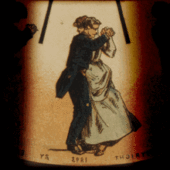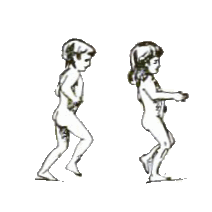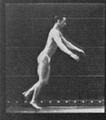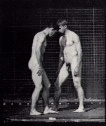Physicality—when kids need more activity
(note, this is a text copy from the website sandradodd.com, but a fair amount of it was compiled or written by me, so I'm saving it here)
Ideas posted by Meredith on Always Learning, June 2012, for use in a small apartment:
Make forts and tunnels in the living room using blankets and cushions—crawl around and through and over them.
Twister. And make up other games to play with the board, like hopscotch, jumping from one color to another. Jumping games in general are fun—how many times can you jump? Jump on one foot? How high can you jump? Jump rope (inside, if you have the space, you can tie one end to a doornob and "turn" the other end for him. Or have jumprope races down a hallway (make sure the downstairs neighbors aren't home).
Get some flimsy fabric or scarves and dance with them. If you have a big enough piece of fabric you can toss it up in the air and try to get under it before it lands.
Play games with balloons—volleyball, soccer, and if you can do it without disturbing the neighbors "balloon stomp" where you tie a balloon to one leg and see how quickly you can break it by stepping on it.
Toys like a sit-n-spin, a skateboard (use it sitting down), an exercise or bounce ball, an inflatable punching bag, and a mini trampoline can be stored and brought out one at a time.
Party games like blind-mans-bluff and pin-the-tail can be played easily at home with one or two kids. Get a book of party games, or look some up on the web.
Wind down by transitioning to something else, rather than just "that's enough". A snack makes a good transition, or switch to video games or a movie.
Meredith Novak
 Pamela C. added:
Pamela C. added:
We live in a tiny apartment in New York City. My son does not like to go out (the hustle and bustle overwhelms and irritates him). Here are physical things we do inside every day:
-we constantly play/roll on/bounce on our huge exercise ball
-jump rope . We have an ongoing contest for how many jumps we can do without messing up
-play Dance Dance Revolution
-bounce on hippety hops (Ours is bug enough for me to ride on)
-Dance to music. Everything from hip-hop to tango
-We have a game that involves trying to knock each other over with pillows on the queen-size bed
-setting up "Wipe-Out" style obstacle courses on the furniture (putting slip covers on things helps me to chill out about damage)
-play "Bop-it Bounce" ball game: http://www.amazon.com/Hasbro-20163-Bop-It-Bounce/dp/B0036RIMNQ
-juggle
-many many improvised games with our dog involving stuffed animals, balls, treats, etc.
-a ping-pong set that we set up on our dining room table. We use pennies to keep score and play real sets. A few weeks ago we had a friend over and played for the "championship." Cheap and still a favorite after years! You can get it for about $10: http://www.coolstuffexpress.com/table-top-ping-pong-set.html?feed=Froogle
-inflatable swords and socker boppers
-sit-and-spin
-trying to keep a ballon from touching the floor can be incredibly entertaining and active, especially for little kids.
-a small indoor trampoline. They come with or without a handlebar.
-basketball with an over the door hoop and soft, spongy balls
-a few years ago I bought a bunch of upholstery foam remnants super cheap from a furniture repair place. We used them to build all kinds of things you could jump and fall and climb on. We stored them under the bed.
-until recently, we've always had an indoor swing. This is the model and it's very easy to install in a doorway: http://www.amazon.com/Rainy-Day-Indoor-Piece-Combo/dp/B000W0A1NE/ref=pd_sim_sbs_t_1
It's a little pricey, but we've used ours for over a decade (my eldest is 21).
 We do all of this and more, alone or with friends. On a bigger scale, I have scrimped and saved all year to be able to leave the city for the summer and stay at a cabin on a lake so my son can spend his days in the country swimming, which is something he loves. There are lots of solutions, big and small, for helping kids get physical needs met.
We do all of this and more, alone or with friends. On a bigger scale, I have scrimped and saved all year to be able to leave the city for the summer and stay at a cabin on a lake so my son can spend his days in the country swimming, which is something he loves. There are lots of solutions, big and small, for helping kids get physical needs met.
It sounds like your son doesn't really enjoy crowds of other kids or playing at the park. Mine doesn't either and forcing him into those situation was harmful to him and to our relationship. Hope these ideas help.
Pamela
Pam Sorooshian's list from the same discussion:
I realize an apartment may not have a lot of space - but it is worth it to
clear out some furniture to make enough space for large-body play. Mini-trampolines in front of the tv!! We ended up, at one time, with two of
them and that was a HUGE draw - to bounce back and forth.
Mini-trampolines in front of the tv!! We ended up, at one time, with two of
them and that was a HUGE draw - to bounce back and forth.
Twister - the game.
Hula hoops can be used indoors.
Tunnels, yo-yos, spinny things you stand on.
Bean bag toss games—here is one you can buy, but you can just make bean
bags (fill tube socks with rice or beans or hard corn and tie a knot in the
end) and find places to throw them—allow for him to be able to throw
HARD, not just gently toss, too.
http://www.orientaltrading.com/tiki-bean-bag-toss-game-a2-34_1884.fltr?prodCatId=388930&tabId=4
Oriental trading company also has an inflatable limbo game. But you could
just play limbo with him using a broomstick.
Play "run, jump, punch"—duct tape a "target" (something he can punch - an
old throw pillow, for example) onto a broom handle - hold it out and let
him run at it and punch it (or jump/kick it, even better). Then hold it a
little higher and a little higher&mdashmake it more of a challenge (but not so
high as to frustrate him—his is supposed to be fun).
Paddle balls—those things with a little rubber ball connected to a paddle
with elastic.
Balloons—play together trying to keep a balloon in the air. Same with
feathers.
We had a big peacock feather for years—and the kids would move all over
the room trying to keep it balanced on the tip of their finger.
Play hopscotch in the house. I bought a set of placemats at a thrift store—plastic ones. I got several sets. We ended up writing numbers on them and
the kids would lay them out in the living room and play hopscotch on them
(and use them as part of their obstacle courses).
Also play "sharks" or "lava"—put old placemats or sheets of newspaper or
anything else—all over the room, just far enough apart that it is a
challenge to go from one to the other and then hop around pretending that
if you step off either the sharks will get you or you'll be in hot lava.
Those big cardboard brick building blocks http://www.amazon.com/Giant-Building-Block-40-piece-Set/dp/B00005ICC4)
Combine these with small tables and chairs and cushions and more - to
build BIG structures.
Drag home large appliance boxes if you see them—kids can find all kinds
of ways to play with them and they encourage large muscle play.
Those little parachute guys that he can climb up high and drop (or look
online you can make these easily).
Put up a short step ladder in the middle of the living room—play pretend
with it. Drop parachutes off it. Every time he climbs up and down—that's
good!
Jump ropes—play "snakes" by wiggling it as you move around the room and
he tries to stomp it. Make up more games with ropes.
Make "obstacle courses" throughout the apartment—put couch cushions and
pieces of newspaper and other things (a mini trampoline in there somewhere)
and things to crawl over and crawl under (coffee tables, chairs) and get a
stopwatch to time it.
Dance—put on happy high-energy music and dance around the apartment. My
kids liked scarves—ong flowing scarves to wave around while they danced.
There are really cheap little paper thingies that sort of unwind and you
wave them around in patters while you dance—like gymnasts use.
Punching bags! Those bouncy balls kids can sit on and bounce around. I know
I know—doesn't seem safe for indoors—MAKE it safe.
Make it a priority—spend hours every single day outdoors where he can
run and play. Play WITH him if he's not finding other kids to play with. If
you're having fun together, why would he be sitting and crying. Take bubble
stuff and weird bubble wands that you make out of pipe cleaners. Do the
mentos experiment. Get those cheap little balsa wood gliders and fly those
(and chase them). Make a little scooter ramp to take to the park. Make life
outdoors fun and run around with him and climb up on the playground
equipment with him and slide down the slide and haul water for him so he
can build castles with moats in the sandbox.
That he has trouble sharing isn't a reason to not take him out. Be there to
help. Think ahead—take something that he is willing to share or don't
take toys at all. Most kids on playgrounds don't bring their own toys—
mostly they play on the playground equipment. Second—you don't have to go
to playgrounds—go to parts of parks where there are trees and bushes to
run around in, too. Take a ball and play with him.
 Playing in the bathtub is really good—being immersed in water is an
extraordinary calming and physically nurturing thing. Bathtub play was kind
of a lifesaver for me with my extremely high-energy and intense kid! I'd
put all kinds of things in the tub—egg beaters, cups and bowls, measuring
cups, basters, and so on. An empty tub and a big huge bowl of instant
pudding was great—they played and played with it —and it washed right
away. Bubble baths—of course—but be creative with them (add flavorings
like pineapple or chocolate to the water, for example). Baths were really a
focal point of our days during winter months. (Put towels on the floor and
don't worry about it getting wet.)
Playing in the bathtub is really good—being immersed in water is an
extraordinary calming and physically nurturing thing. Bathtub play was kind
of a lifesaver for me with my extremely high-energy and intense kid! I'd
put all kinds of things in the tub—egg beaters, cups and bowls, measuring
cups, basters, and so on. An empty tub and a big huge bowl of instant
pudding was great—they played and played with it —and it washed right
away. Bubble baths—of course—but be creative with them (add flavorings
like pineapple or chocolate to the water, for example). Baths were really a
focal point of our days during winter months. (Put towels on the floor and
don't worry about it getting wet.)
It is very sad when a child is diagnosed as having ADD or hyperactivity or
whatever—but the kid is a rambunctious little one who is mostly being
kept indoors in an apartment and not getting hours of strenuous big-body
play time every day - then the poor kid gets drugged and treated and talked
about as if there is something wrong with him! Instead of considering him
as disabled in some way and trying to treat it—consider him as an
extremely rambunctious kiddo who needs a tremendous amount of physical
activity. Make it your goal and your priority that he is physically worn
out at the end of every single day. End the day with long playtime in the
bathtub.
Focus your own energy on being super creative about fun things to do
together that involve large-muscle activity.
The list of suggestions and activities below was created by Pat Robinson (aka wuweimama) (in 2010?) and is used with her permission.
Pat R's sensory activities:
"Choo-choo train" is when he lies on the bed and I "row" his feet like
a bicycle and we chuga-chuga-choo-choo (he does the train whistle
sound) and we repeat that over and over for about 5 minutes. The
engagement, physical motion and my participatory resistance/driving of
his legs back and forth provides a lot of sensory input in a
non-impact way.
Another is "pillow mash"-again he lies on the bed and I place a pillow
on top of his chest and firmly "aggitate" the pillow in a jiggling
motion and say "pillow mash, pillow mash", repeatedly. This provides
input to his chest.
And another one is "salt shaker", again he lies on the bed, and I hold
both legs up and "shake salt" out of him. He is sorta upside down
(legs up in the air, body on the bed), which gives input of vibrating
his head and back on the firm mattress.
Another is "burrito"-where he is wrapped tightly in a blanket and
rolled side to side repeatedly.
Another is "sack of potatoes" when he climbs in a pillow case and I
lift him up and down from the floor.
We also do "row-row-row-your boat" where we both lie on the trampoline
with full body contact and roll across the surface back and forth,
singing row-row-row-your boat. The total body compression is very
calming for him.
We have his bed mattress and box springs on the floor. So, he'll go up
to his room and bounce and jump for sensory input too.
Oh, also he loves to stand in place and jump up to reach my hands
above his head. This is helpful when waiting in line, where he is
restless, but needs contained activity. It creates jumping, reaching
and a goal/game aspect.
Another is where I hold my hands together palm to palm and move them
up and down and he tries to clap them with his hands. Again, this is
great for when out and about and he has too much energy for the space
limitations. A variant of this is where he tries to "give five" while
I pull my hands back quickly. These can be used to constructively
engage other people in the "game" also, which might free you up for
short periods.
He also loves to play in the sink with LOTS of soap, that seems to be
very soothing to him (but messy). Some kids really seek multiple baths
a day and having that planned before and/or mid-visit may allow a
connecting time with you; and a recentering activity, enough to make
it a longer night.
So, if we are going to have a lot of sensory stimuli like a cacophony
of sounds from a crowded party, we proactively do these games for 15
minutes several times throughout the day. It helps if we are very
careful to avoid dairy, HFCS and artificial colors which decrease his
ability to hear and consider other's needs. We try to plan activities
for earlier in the day, plan some outside play time, especially
swinging. Big tight, long hugs help in the midst of chaos to recenter.
We also freely use Rescue Remedy (and/or Cherry Plum) Bach flower
remedies before (and during) high stress situations.
Ds has no obligation to visit with company; and he freely removes
himself to go watch tv in his room. It helps if ds doesn't need to
meet and greet everyone, especially when they all want to be hugging
him and expecting him to chat. He'd rather warm up to people like a
cat...on his own terms. So, it helps if ds is quietly engaged with a
familiar video when we have company arrive and then he can come down
when he is ready and everyone is sitting and he is out of arm's reach.
Then he is apt to go sit with someone and visit. He is an introvert.
It probably helps to practice some of these games so that they are
fun, known and can be anticipated. Perhaps, make a list, or place a
name of each game on a piece of paper and have her choose one from a
jar to play with you or others.
more sensory/physical activities
Oh, and here are more.
Sensory Activities
Here is a another list of various sensory activities that child(ren)
may enjoy and benefit from. I am copying this from
ShineWithUnschooling. I find that proactively offering and engaging
our son with some of these sensory inputs really helps when we
have/had a busy day. If we have too much unfamiliar stimuli, he needs
a break to recenter with some of these soothing activities. Or
else......meltdown!
==========
CALMING ACTIVITIES:
Experiences that may help to relax the nervous system
* Stretches
* Deep pressure massage
* Slow rocking or swinging
* Fidget toys
* Progressive muscle relaxation
* Quite music with a steady beat
* Bear hugs
* Reduced noise and light levels
* Lavender, vanilla or other soothing smells
* Snuggling in a sleeping bag, large pillows or bean bag chair
ORGANIZING ACTIVITIES:
Experiences that can help an individual become focused and attentive
*Sucking or chewing on hard candy or gum
* Adding rhythm to the activity
* Vibration-toy massager, vibrating pillow, wiggle pen
* 'Heavy work' tasks to include hanging, pushing, pulling or carrying
heavy objects
Similarly:
To organize
*Swinging on a swing or climbing
* Rhythmical sustained movement: marching, washing a table, or bouncing
* Rocking in a rocking chair
* "Squeezie" toys (koosh balls, balloons or rubber gloves filled with
flour or cream, soft balls, gak, silly putty)
* Hanging by the arms on the monkey bars (20-30 seconds)
* Pushing/carrying heavy objects
* Carrying back packs weighted with books or bags of dried beans (this
should only be worn for 15-20 minutes with an hour or two between)
*A reading corner with a bean bag chair makes a wonderful place for
escape when there is too much stimulation. Some children may like the
bean bag on top of them.
* Play dough
* Tactile Bins (cornmeal, oatmeal, water, sand, rice, beans)
* A bin full of bird seed (brought outside) is merrily cleaned up by
the birdies -- no mess! :')
* Kitchen time (mixing, tasting, smelling, washing up)
* Finger painting
Some children also need extra sensory input in their mouths and hands
in order to organize their behavior:
* Drinking from a water bottle
* Chewing (you can use a straw, rubber tubing or coffee stir stick)
* Being brushed with a corn de-silking brush (in one direction
approximately 10 times with pressure brush their arms, back (but not
over the spine), legs (on the top, outer parts and underneath, avoid
the inner thigh area), top of the feet and the hands)
* Sucking on hard candy, frozen fruit bar, or spoonful of peanut
butter or marshmallow fluff
* Licorice tug-of-war, blow pin wheels or various types of blow toys,
bubbles and whistles
* Pushing against walls with the hands, shoulders, back, buttocks and head
* Cuddling or back rubbing
* Taking a bath
* Being rolled tightly like a hot dog in a blanket
* Being squished under a therapy ball, mat or couch cushion
* Tug-of-war
* Wheelbarrow walking, jumping games like hop scotch
* Crashing games-run and dive into boxes, bean bags and couch cushions
* Pulling a wagon, carrying a heavy book bag, digging in the yard or
carrying groceries
* Sports such as wrestling and football
* Deep pressure (giving a massage) and joint compressions (holding
above one joint and under one joint then doing a quick 10 repetitions
of compressions, pushing and pulling)
* A mini trampoline
* A sockem bopper or whatever they call those weighted kid-sized
things that spring back up after you knock them down
-------------------
Originally posted here:
sandradodd.com/physicality/

 We do all of this and more, alone or with friends. On a bigger scale, I have scrimped and saved all year to be able to leave the city for the summer and stay at a cabin on a lake so my son can spend his days in the country swimming, which is something he loves. There are lots of solutions, big and small, for helping kids get physical needs met.
We do all of this and more, alone or with friends. On a bigger scale, I have scrimped and saved all year to be able to leave the city for the summer and stay at a cabin on a lake so my son can spend his days in the country swimming, which is something he loves. There are lots of solutions, big and small, for helping kids get physical needs met.  Mini-trampolines in front of the tv!! We ended up, at one time, with two of
them and that was a HUGE draw - to bounce back and forth.
Mini-trampolines in front of the tv!! We ended up, at one time, with two of
them and that was a HUGE draw - to bounce back and forth. Playing in the bathtub is really good—being immersed in water is an
extraordinary calming and physically nurturing thing. Bathtub play was kind
of a lifesaver for me with my extremely high-energy and intense kid! I'd
put all kinds of things in the tub—egg beaters, cups and bowls, measuring
cups, basters, and so on. An empty tub and a big huge bowl of instant
pudding was great—they played and played with it —and it washed right
away. Bubble baths—of course—but be creative with them (add flavorings
like pineapple or chocolate to the water, for example). Baths were really a
focal point of our days during winter months. (Put towels on the floor and
don't worry about it getting wet.)
Playing in the bathtub is really good—being immersed in water is an
extraordinary calming and physically nurturing thing. Bathtub play was kind
of a lifesaver for me with my extremely high-energy and intense kid! I'd
put all kinds of things in the tub—egg beaters, cups and bowls, measuring
cups, basters, and so on. An empty tub and a big huge bowl of instant
pudding was great—they played and played with it —and it washed right
away. Bubble baths—of course—but be creative with them (add flavorings
like pineapple or chocolate to the water, for example). Baths were really a
focal point of our days during winter months. (Put towels on the floor and
don't worry about it getting wet.)



